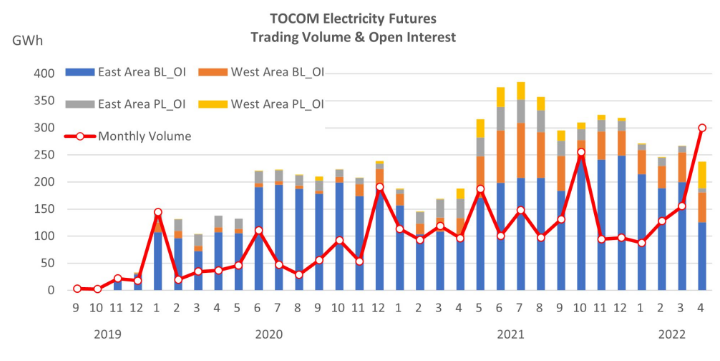TOCOM Energy
JPX Energy Market Updates(Nov.21, 2022)
Welcome back to JPX energy market updates.
The oil market came under pressure last week. A partial recovery in the USD put pressure on oil and the broader commodities complex, but a poorer demand outlook and the easing of tightness of the European market appears to have been the key catalyst for the downside move. Easing geopolitical tensions between Russia and NATO over Ukraine also helped add to the selloff.
Crude prices started the week on a bearish note as mixed messages from China over its Covid policy continued to cause uncertainty. Sentiment was further rocked after the OPEC and IEA said demand growth will slow in 2023.
OPEC revised their demand growth forecasts for both this year and 2023 down by 100Mbbls/d. OPEC forecasts demand for their crude oil to be 29.3MMbbls/d in 2023, compared to output in October of 29.49MMbbls/d. Given the sizeable supply cuts from November through until the end of next year, OPEC supply will still be lower than demand for OPEC oil over 2023.
The IEA lifted its oil demand forecast for this year on an upward revision to Chinese consumption, while 2023 has been reduced by 40 kb/d. Demand will remain lacklustre during 1Q23 will regain meaningful momentum in 2Q23, going beyond 2019 levels in the process.
The IEA warned a tight distillate supply will remain a drag on oil demand in the months ahead, with high diesel prices feeding into inflation and weigh on its role as a driver for economic growth.
Global diesel/gasoil growth is forecast to ease from 1.5 mb/d in 2021, to 400 kb/d in 2022 before posting a small decline in 2023 under the weight of persistently high prices, a slowing economy and despite increased gas-to-oil switching.
On the supply side, the IEA expect that world oil production to increase by just 740 kb/d y-o-y to 100.7 mb/d. Non-OPEC+ output will rise by 1.8 mb/d, led by the US (1 mb/d) and to a lesser extent Brazil’s 300 kb/d and Norway’s 270 kb/d. If maintained through 2023, the OPEC+ decision to cut official production targets slows growth outside of Russia to just 340 kb/d.
The IEA also expect that Russian oil output to fall 1.4 million bpd next year after the EU ban on seaborne exports comes into effect for crude next month.
But for now, Russia has largely mainlined production levels, output in the first half of November has shown signs of edging higher, with reports from the country suggesting daily output was 1% higher than last month at 1.48 million mt.
Russian Urals crude is classified as a medium sour crude with the closest quality matches typically found in the Middle East, heavier barrels such as Iraq’s Basrah Medium are being sought and blended with lighter grades to create a Urals lookalike.
With the embargo looming, the shift in Russian oil exports has become more urgent, Russian continues diverting cargoes from its core European customer base to Asia and competing with middle east producers. This has distorted prices to the upside in favour of Europe than Asia, although Middle East suppliers are set to step up Westbound shipments in a broader reset of crude oil flows.
The Brent/Dubai cash spread raced to a fresh five-month high as European refiners scramble to secure replacement barrels ahead of looming sanctions, while sluggish demand in Asia and increased competition from Russian barrels has weighed on East of Suez markets.
The excess supply of crude into Asia has also seen a sharp contraction in the Dubai cash market structure with the prompt M1/M3 spread (Jan23/Mar23) valued Wednesday at a fresh six-month low of $2.40/b, while the one-year curve was hovering around $8/b, the lowest since January.
There are signs of weakness on the European market as well, weeks-long strikes at French refineries and a rash of refinery maintenance also curbed the call for crude oil in Europe as runs slowed. European refiners have found themselves oversupplied with crude as an expected shortage owing to the looming EU ban on Russian oil has yet to materialise. At the same time, the downward trend of European diesel crack spread continued as rising imports into the region weighed. Diesel arrivals into Europe from Russia, the Middle East, Asia and the United States are expected reach 3 million tonnes so far this month.
US commercial crude inventories drained 5.4 million barrels in the week to 11 November as runs ticked up and imports fell, according to the latest EIA data, in addition to a 4.1 million fall in strategic reserves. The draw put stockpiles 4.6% behind the five-year average for this time of year, opening the widest deficit to normal since late August. Because the European market has been the core of the Atlantic basin makret this year, the drop of US crude stocks didn't bring any relief to the short term downward pressure.
Prompt time spreads have weakened significantly, as the front-month and third month Brent spread narrowed to around $1/b, while Dec/Jan WTI flipped into contango.






